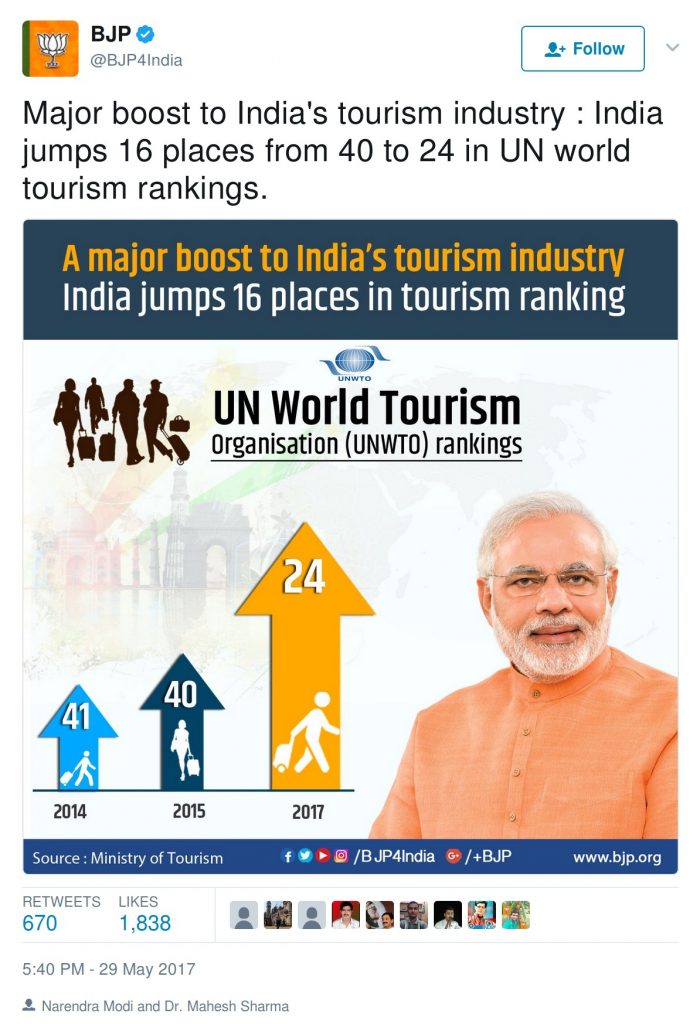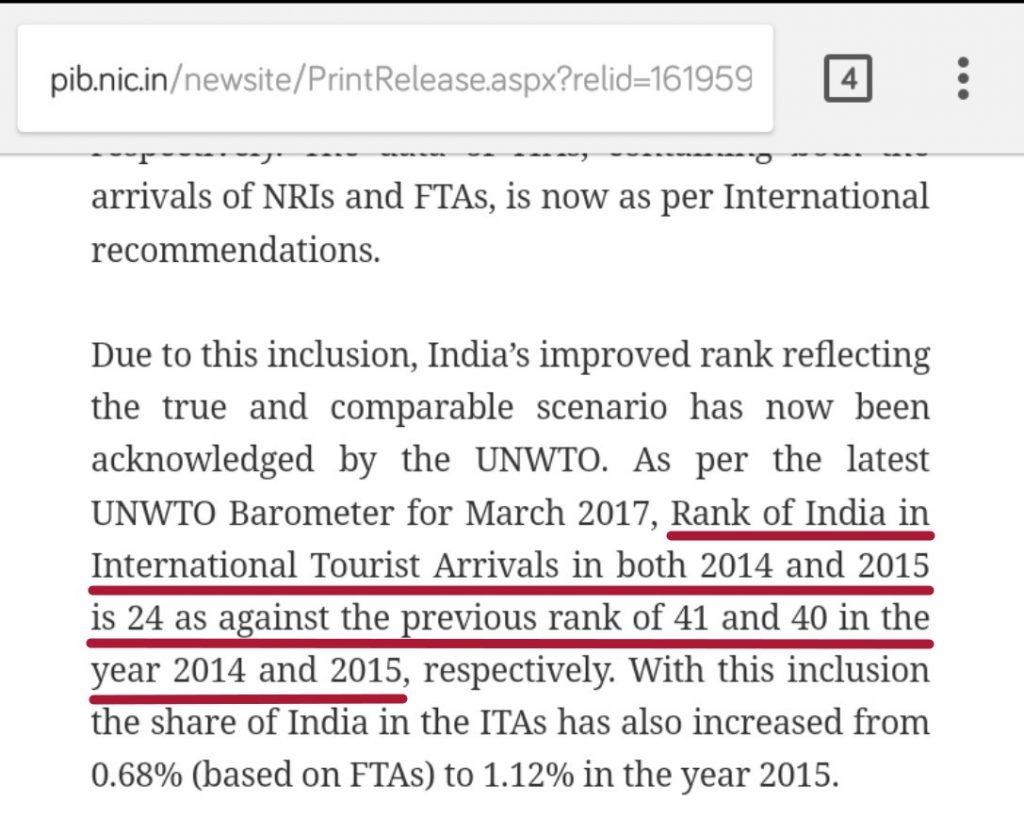Completion of three years of Modi Sarkar, has seen a number of infographics on achievements being shared on social media. BJP’s official handle recently tweeted the news about “Major boost to India’s tourism industry: India jumps 16 places from 40 to 24 in UN world tourism rankings”. On the face of it, it looks like an impressive achievement. On second thoughts, one is left wondering if international tourist arrivals went up so much in the space of one year to make such an impact on the ranking. With this lingering doubt in mind, let us do a quick fact check.
Here is the claim that was tweeted by the official handle of BJP and subsequently retweeted by Union Minister of State for Culture & Tourism, Mahesh Sharma.

New definition of International Tourist Arrivals (ITAs)
On May 19th, 2017, Ministry of Tourism had come out with a press release about the improvement in India’s rank in International Tourist Arrivals (ITAs). The release explains a very significant change in methodology i.e., earlier India only reported foreign tourist arrivals under ITA and has now started to report NRI arrivals as well.
“As per the UNWTO definition, International Tourist Arrivals (ITAs) comprises two components namely Foreign Tourist Arrivals (FTAs) and Arrivals of Non-Resident Nationals. The UNWTO in its barometer ranks countries in terms of their ITAs. So far only the figures of FTAs were compiled in India. However, now India has started compiling the data arrivals of Non-Resident Indians (NRIs), also.”
This is a major change in methodology. It means adding 40% more tourist arrivals to the ITA number. Accordingly, with an addition of 5.43 million NRIs in 2014 and another 5.26 million in 2015, the number of ITAs in India during 2014 and 2015 became 13.11 million and 13.28 million.
The same was reported in the travel industry as, “India changes tourist count”.
It is no surprise that the addition of NRI data led to a massive jump in India’s ranking. The PIB press release clarifies that ranks for years 2014 and 2015 were reworked after the inclusion of NRI arrivals:
“Due to this inclusion, India’s improved rank reflecting the true and comparable scenario has now been acknowledged by the UNWTO. Rank of India in International Tourist Arrivals in both 2014 and 2015 is 24 as against the previous rank of 41 and 40 in the year 2014 and 2015, respectively.”

This can be summarised as follows:
| Year | Original Ranking | Revised Ranking based on new methodology |
| 2014 | 41 | 24 |
| 2015 | 40 | 24 |
| 2016 | n.a | n.a |
It is clear from the press release that this is a revision of previous years’ rankings and there is no mention of the rank for 2016 or 2017. The same also could not be found on UNWTO or Ministry of Tourism website. Even if we take the BJP claim that the 2016 rank is 24, it has to be compared to the revised base of 24 for 2014 and 2015. As per these numbers, India’s ranking on International Tourist Arrivals is still flat since 2014.
The claim of a 16 places jump in the ranking on International Tourist Arrivals in 2016 is thus misleading as per the Ministry of Tourism’s own press release. Just the way GDP formula was reworked to show a higher GDP, BJP’s presentation of tourism rankings are also a play of numbers rather than actual ground reality.
So what is the real picture of International Tourist Arrivals? Once again, as per the Ministry of Tourism’s own data:
| Year | Foreign Tourist Arrivals (million) | Growth (%) |
| 2010 | 5.78 | 11.8% |
| 2011 | 6.31 | 9.2% |
| 2012 | 6.58 | 4.3% |
| 2013 | 6.97 | 5.9% |
| 2014 | 7.68 | 10.2% |
| 2015 | 8.03 | 4.5% |
| 2016 | 8.89 | 10.7% |
Before the global economic crisis of 2008, India had seen an increase in tourist arrivals in the range of 13-14% with 2004 being as high as 26.8%. The arrivals picked up again in 2010. After a fall in 2015, the year 2016 has again seen a healthy 10.7% growth. Even though it won’t lead to a 16 point jump, this growth will ultimately get reflected in an improvement in India’s ITA ranking.
Misunderstanding or Miscommunication?
To sum up, as per the PTI story based on the Ministry’s press release: “With the inclusion of non- resident Indians among international tourists, India has jumped 16 places in the revised World Tourism Organisation (UNWTO) rankings to settle at 24th for 2014 and 2015. Earlier, it was ranked 41st and 40th in 2014 and 2015, respectively, as per the global ranking.” So, the so-called “jump” is nothing more than recalculated 2014 and 2015 ratings. There is no mention of a jump in 2016 or 2017 ratings.
The PTI story was also carried by LiveMint with a misleading headline but it explained correctly in the article. Financial Express went a step further and reported this recalculation as “PM Modi’s tourism push pays off, India jumps 16 places in UNWTO ranking”.
While we can give the benefit of doubt to the media for not fully understanding the numbers and carrying a misleading headline, what is the excuse for BJP’s official handle and Minister of Tourism to tweet it? This brings us to the question of why a misleading claim had to be made when all government data and press releases are publicly available? Why this chest-thumping at the cost of credibility?
The news of improved rank was shared across social media and the misleading infographic has made its way to hundreds of WhatsApp groups as a major achievement of the government. Facts unfortunately are the first casualty in this eagerness to show an achievement. The second is credibility. And to share a misleading claim as a major achievement along with the picture of the Prime Minister is not even considered an embarrassment.
Independent journalism that speaks truth to power and is free of corporate and political control is possible only when people start contributing towards the same. Please consider donating towards this endeavour to fight fake news and misinformation.




